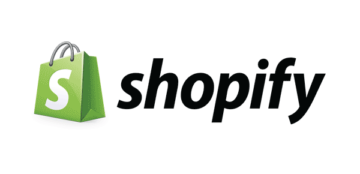Shopify
With Shopify, it is easy to build your own online store without any coding or design skills. The software is very popular, especially among merchants who sell cross-channel or internationally. Whatever plans you have for your online business, Shopify has apps or plugins to help you set it up.
Content
- What is Shopify?
- Getting started
- How does Shopify work?
- Using themes, custom storefronts and checkout
- Integrating plug-ins
- Using Shopify partners: fulfilment, marketing and dropshipping
- Costs of using Shopify software
 What is Shopify?
What is Shopify?
Shopify is a Canadian ecommerce software provider. Shopify was founded in 2006 by Tobias Lütke and Scott Lake. They wanted to start selling online, by creating an online store for snowboarding equipment. However, they were dissatisfied by existing ecommerce software. They used an open source framework to launch Shopify.
The company sells a hosted ecommerce software package. For a fixed monthly rate, the software can be used to sell products online and in brick-and-mortar stores. As it is a cloud-based platform, users automatically receive updates.
Shopify can be easily integrated with other channels.
Looking for ecommerce software to start selling in Europe? Webador and Shopify are platforms that are well optimized for cross-border ecommerce.
Software for all kinds of sellers
 According to the ecommerce platform, millions of merchants worldwide use its software. The company’s features are mostly geared towards SMEs. The platform is easy to integrate with other sales channels, such as Instagram or Facebook.
According to the ecommerce platform, millions of merchants worldwide use its software. The company’s features are mostly geared towards SMEs. The platform is easy to integrate with other sales channels, such as Instagram or Facebook.
Whether you want to create an online store running only on Shopify’s software, or if you just want to add a checkout to your existing WordPress website, Shopify can help. There are so many possibilities and integrations that help selling on Shopify, it can support almost any kind of ecommerce business. Because of that, you should decide on some things before you launch your Shopify store.
Highly customizable software
Do you want to sell cross-border? There are features to help you with that. Or maybe you just want start selling online without buying inventory, by dropshipping your products. The software platform has multiple apps that provide you with dropshipping suppliers.
If you already have a website, you can integrate Shopify’s Buy Button to start selling.
Additionally, the ecommerce software provider supports many online sales channels, in addition to the online store itself. In the Shop App, you can post and sell products directly on your Facebook or Instagram page. If you already have a website, you can also use a Buy Button and sell from your own website or blog. The button connects with your Shopify checkout. Do you also own a brick-and-mortar store? Then using point-of-sale hardware could be useful.
Getting started with Shopify
The first steps to create your store on Shopify are choosing a store name and setting your legal business name. After that, enter your business address and billing information. You should also set the default currency of your store, add a weight unit for product listings and set up your shipping. But also think about pickup, local delivery, tax information, payment options, and set up your domain.
Place some test orders to find out how your checkout works.
After those basics, you can work on the lay out of your store. This is also when you can add content, such as a blog. The software provider also gives you the opportunity to test your store by placing test orders. That way, you can see how the checkout process works.
How does Shopify work?
 Users can build their own website by choosing a domain, store name and theme. To set up your online store, you will need to use the Shopify Online Store Editor. Within the editor, users can choose a template and drag-and-drop modules to customize their store. If you prefer making your website on a mobile device, you can download the Shopify mobile app and use the store editor in it.
Users can build their own website by choosing a domain, store name and theme. To set up your online store, you will need to use the Shopify Online Store Editor. Within the editor, users can choose a template and drag-and-drop modules to customize their store. If you prefer making your website on a mobile device, you can download the Shopify mobile app and use the store editor in it.
Without programming skills, you can still build your own online store.
Shopify has tens of free themes and hundreds of templates for a fee in the Shopify Theme Store. This makes it possible even for people without programming skills to build their own online store. The company also offers a free trial period, so that sellers can try out the software first.
Themes
Shopify Themes are optimized for selling online, which means that your store will load fast, is mobile-friendly and has an optimized checkout. It also has built-in features that make it possible to offer discounts, recommend products or save emails from customers. Sellers can save up to 20 themes in their account but only one can be published at any time.
All software from Shopify is regularly updated.
Just like all of Shopify’s software, themes are regularly updated so that as a seller, you always have the latest version. Some themes even come with built-in translations, which makes them suitable to cross-border sellers. Knowing what you want to achieve with your online store is important when choosing a theme.
Custom storefronts
While there are a lot of useful themes and templates to use, Shopify also offers custom storefront tools. This requires a bit more work, but gives Shopify merchants the opportunity to personalize their online store’s appearance. Customized websites can be built with JavaScript SDK. Sellers often hire a developer to do this for them.

Shopify checkout
In addition to the software needed to create your own online store, the software developer has more built-in solutions. To immediately start selling, you need a checkout. Shopify has an integrated checkout that processes payments as well, so there is no need to look for a payment service provider.
The checkout is also able to convert customer data into reports, which gives Shopify stores insight into their customer base. These reports focus on the returning customer rate or on the amount of times that a discount code was used, for example.
You can also use Shopify’s point-of-sale system for your physical store.
Online sellers who also own a brick-and-mortar store can use the software provider’s all-in-one POS system. This makes it easier to track inventory, as well as payments and manage staff across all sales channels.
Additional products and apps
 The tools mentioned above come with the company’s core product, but Shopify also has upgrades for businesses with other wishes. It has its own Shopify App Store with thousands of apps and features built by partners. By adding an app, sellers integrate even more functionalities without needing to access the code. There are plug-ins to help businesses send texts to customers, but also social media network ad tools.
The tools mentioned above come with the company’s core product, but Shopify also has upgrades for businesses with other wishes. It has its own Shopify App Store with thousands of apps and features built by partners. By adding an app, sellers integrate even more functionalities without needing to access the code. There are plug-ins to help businesses send texts to customers, but also social media network ad tools.
There are over 1,500 apps to add more functionalities to your online store.
There are apps to add reviews, loyalty programs, customer whislists or even get more analytics. You could also integrate an app to print labels or to integrate with shipping programs. There are also plug-ins to connect your store with accounting software. According to Shopify, there are over 1,500 apps in the Store. Many of them are free, but over half of them charge a fee.
Shipping and fulfilment
If you are selling products online, you will need to figure out how to send them to your customers. In your shipping profile, you can add shipping rates that apply to all your products or set specific shipping rates per product. For businesses with eligible locations, the software provider also offers Shopify Shipping. With this solution, you can connect your Shopify account with a carrier and buy and print shipping labels directly from your profile.
Shopify has many European logistics and fulfilment partners.
Shopify also has its own ecommerce fulfilment solution for its merchants. The fulfilment service will store your inventory and fulfil your orders. It also helps you manage business data, like shipment tracking, customer details and inventory. If your online store ships orders to the US or Canada at least once a day, you can apply for this solution. However, Shopify has also partnered up with many European fulfilment companies.

Dropshipping
If you are interested in selling through dropshipping, there are several ways to do that with your Shopify store. The software provider has multiple plug-ins that connect you with dropshipping suppliers. Previously, Shopify had its own dropshipping-plugin, called Oberlo. In 2022, the app was delisted.
There are many dropshipping suppliers to connect to your Shopify store.
Shopify has enough partners to help you start selling all kinds of dropshipping products. If you want to sell a design that can be printed on demand on T-shirts, mugs, tote bags, pillows or other products, you can select a print-on-demand app. Suppliers that are connected to these plug-ins can print and ship your products on your behalf. As Shopify offers these integrations, it also provides merchants with a lot of tips to select good suppliers.
Marketing
 The ecommerce software provider also helps merchants with processes that come after a shop’s launch, such as online marketing. It has several tools to increase traffic and convert visitors into customers. In your account, you can visit the Marketing page where Shopify lists marketing recommendations. One of the options is improving your SEO to help customers find your online store in Google or social media. The software also supports promotions such as flash or seasonal sales.
The ecommerce software provider also helps merchants with processes that come after a shop’s launch, such as online marketing. It has several tools to increase traffic and convert visitors into customers. In your account, you can visit the Marketing page where Shopify lists marketing recommendations. One of the options is improving your SEO to help customers find your online store in Google or social media. The software also supports promotions such as flash or seasonal sales.
In Collabs, you can track the amount of affiliate sales.
Additionally, Shopify has created a marketplace-style app called Shopify Collabs. It is an app where sellers can partner with creators, influencers and affiliates. This makes it possible for sellers to track affiliate sales and send payments to affiliates, as you pay commission on orders.
Costs
Shopify’s cheapest plan costs 21 euros per month. For that price, you get access to a lot of functions. But on top of the monthly fee, you will have to add transaction costs and possibly paid plugins and extensions from the Shopify App Store.
The cheapest plan costs 21 euros per month.
For 59 euros per month, you get access to more features and the transaction costs are lower. With the more expensive Advanced plan you pay the highest fixed monthly costs of 289 euros, but you have all the functions and the lowest transaction costs. Which package has the best rates depends partly on your transaction volume.

Shopify Plus
The company’s core product is aimed at SMEs. Its Basic and Advanced Shopify solutions offer a lot of features and are fit to handle up to 10,000 orders a month. But the company has also launched a package for enterprises, called Shopify Plus.
For enterprises selling 10,000 orders a day, Shopify Plus is a good fit.
If you are selling around 10,000 orders a day, then Shopify Plus has more features to help you process those orders. With Plus, you can adjust your checkout and you also get extra options in terms of authorizations for your employees. With this subscription, you can sell your products wholesale to other businesses in a separate storefront. Shopify also gives more support with this package and checks how you can improve your ecommerce store.
Looking for ecommerce software to start selling in Europe? Webador and Shopify are platforms that are well optimized for cross-border ecommerce.
Frequently asked questions
Some frequently asked questions about Shopify are:
How do you build an online store on Shopify?
You can build your own online store in the Shopify Store Editor, by picking an ecommerce store theme and then drag-and-drop modules to customize it. If you want to add more features, you can visit the Shopify App Store. There are apps for almost everything you could want.
Users do not have access to the code behind their online store, which means that they are somewhat limited in their options. The design of an online store will depend on themes built by Shopify, however, they can also be customized to some extent. The advantage to not having access to the code is that sellers do not run any risk of breaking essential code. They also run less risk of getting hacked.
How much does Shopify cost?
If you want to start selling online with the ecommerce software from Shopify, you can choose between several subscriptions. The cheapest one costs 21 euros per month, which gives you access to a lot of features. To get lower transaction costs and even more features, you could spring for the plan of 59 euros per month. Otherwise, go for the Advanced plan and pay 289 euros per month. This gives you access to all functions and lowest transaction costs.
If your ecommerce business has already grown significantly and you are selling at least 10,000 orders per day, you should have a look at Shopify Plus. This software package is geared towards enterprises and gives you access to selling wholesale, for example. You also get more support from the software provider.
